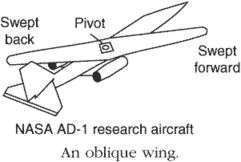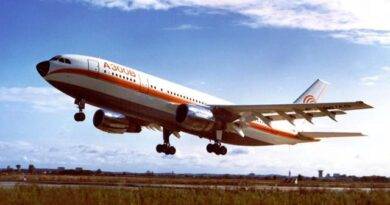Oblique Wings: Twisting the Future of Flight?
Forget symmetrical silhouettes. Oblique wings throw the rulebook out the window, literally twisting one wing forward while the other sweeps back. This radical design, dreamt up by NASA’s R.T. Jones in the 50s, promises to revolutionize aviation across the board.
Why the twist? It’s all about drag. At high speeds, conventional wings struggle with “wave drag,” a nasty energy-sapper. Oblique wings sidestep this by changing their effective sweep angle. The angled wing slices through the air like a hot knife, minimizing drag and boosting fuel efficiency.
But wait, there’s more! Oblique wings aren’t just speed demons. Their morphing ability translates to superior low-speed performance. The straight-on position at takeoff and landing generates ample lift, shortening runways and opening up new airport possibilities.
Sounds too good to be true, right? Challenges abound. Engineering the complex mechanisms to twist the wings reliably is no small feat. Control systems need to be rethought, and pilot training revamped. But the potential rewards are too tempting to ignore.
Imagine quieter, faster, more fuel-efficient aircraft. Think sleek supersonic business jets, eco-friendly cargo planes, and even hypersonic spaceplanes. The possibilities are as limitless as the angles these wings can twist.

NASA AD-1: Testing the Twisting Wings of Tomorrow
The NASA AD-1 wasn’t your average airplane. Built in the late 1970s, it boasted a radical feature: an oblique wing that could pivot asymmetrically during flight. This wasn’t just a cool party trick; it was a daring experiment to explore the potential of variable sweep wings in revolutionizing aviation.
Think of the AD-1 as a flying testbed. Its compact, fiberglass body housed two powerful turbofan engines and a single pilot. But the star of the show was the wing. Unlike conventional fixed wings, the AD-1’s wing could be hydraulically rotated up to 60 degrees, creating a dramatic diagonal angle across the fuselage.
Oblique wings are more than just a design quirk; they’re a glimpse into a future where flight bends the rules. So buckle up, aviation enthusiasts, because the future of flight is looking anything but straight and narrow.
References and Further Reading for Oblique Wing Design:
- NASA Langley Research Center: https://www.nasa.gov/image-article/r-t-jones-oblique-wing-model-test-nasa-ames-11ft-wind-tunnel/
- American Institute of Aeronautics and Astronautics (AIAA): https://www.aiaa.org/docs/default-source/uploadedfiles/education-and-careers/university-students/design-competitions/winning-reports—2021-aircraft-design/3rd-place—graduate-team—university-de-liege.pdf?sfvrsn=131999d5_2
- Desktop Aeronautics – Oblique Flying Wings: An Introduction and White Paper: https://www.desktop.aero/library/ofwwhitepaper.pdf
- image source: By NASA/ – http://www.nasa.gov/centers/dryden/about/Organizations/Technology/Facts/TF-2004-01-DFRC.htmlhttp://www.nasa.gov/centers/dryden/images/content/86987main_TF-2004-01_popup1.jpghttp://www1.dfrc.nasa.gov/Gallery/Photo/AD-1/HTML/ECN-13305.html, Public Domain, https://commons.wikimedia.org/w/index.php?curid=495396


